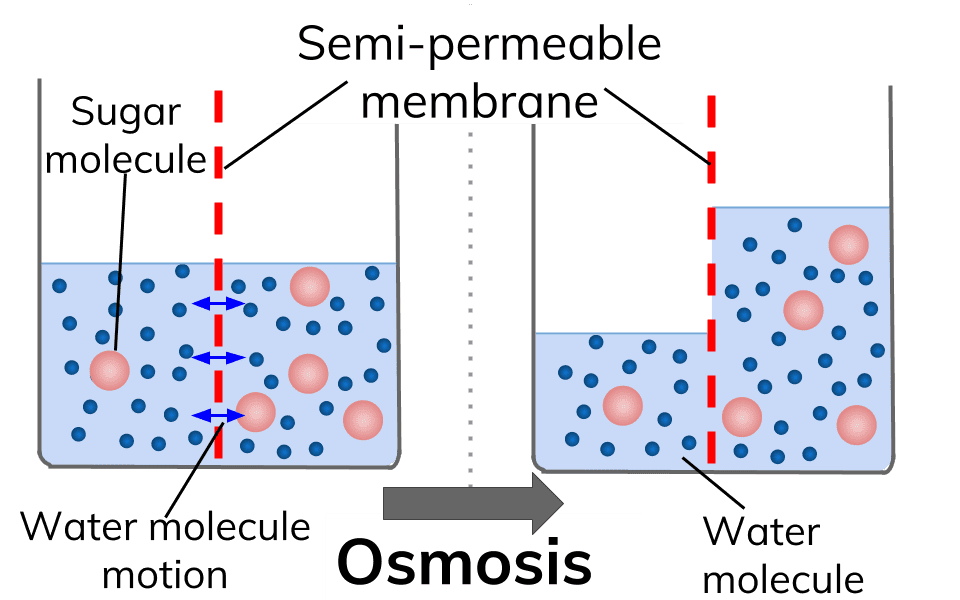

The first type consists of ATP-driven pumps. There are two main forms of active transport in eukaryotic cells. Active transport requires energy expenditure to move a molecule against its concentration gradient. While diffusion would allow the concentrations inside and outside of the cell to move towards equilibrium, a process called active transport helps to concentrate a solute or molecule either inside or outside of the cell. Alternatively, a cell may require extremely low concentrations of a certain solute inside the cell. Sometimes, a cell needs things from the environment that are present in very low concentration outside the cell. It is similar to diffusion of nonpolar molecules or water directly through the lipid bilayer, except that it requires transport proteins. This process is called passive transport or facilitated diffusion. Molecules can travel through transport proteins from high concentration to lower concentration. Both channel proteins and carrier proteins facilitate transport both into and out of the cell. Channel proteins form hydrophilic (“water loving”) openings in the membrane to allow polar or charged molecules to flow through. A second class of transport proteins includes channel proteins. There are carrier proteins (which are also known as transporters or permeases), which bind to a solute or molecule on one side of the membrane and transport it to the other side of the membrane. Transport proteins come in several shapes and sizes, but all extend through the lipid bilayer, and each transport protein has a specific type of molecule that it transports. These transport proteins make up 15–30% of the proteins in the cell membrane. To fix this problem, the cell has transport proteins that allow these molecules to move into and out of the cell. This class of molecules includes ions, sugars, amino acids (the building blocks of proteins) and many more things the cell needs to survive and function. The diffusion of water is given a special name, osmosis.įor larger polar molecules and any charged molecules, entering and leaving the cell is more difficult as they cannot pass through the lipid bilayer. Diffusion does not require energy expenditure. At the same time, CO2 travels out of the muscle cells (where it is higher) to the blood (where it is lower). As oxygenated blood enters the muscle, O2 travels from where the concentration is higher (in the blood) to where it is lower (in the muscle cells). During exercise, the cell converts O2 to CO2. Likewise, if there are more outside the cell, molecules will flow into the cell until a balance is met.

This means that molecules will flow out of the cell if there are more inside the cell than outside. The tendency of molecules to move according to their concentration gradient (that is from higher concentration to lower concentration) is called diffusion. Small, polar molecules (including water) are partially hindered by the lipid bilayer but can still pass through.įor molecules that can freely pass through the cell’s membrane, whether they travel into or out of the cell depends on their concentration. Larger hydrophobic organic molecules can also pass through the plasma membrane, including certain hormones (such as estrogen) and vitamins (such as vitamin D). This class of molecules includes gases such as oxygen (O2), carbon dioxide (CO2), and nitric oxide (NO). Hydrophobic (or oil soluble), nonpolar molecules can freely diffuse through the cell membrane unimpeded. The lipid bilayer does not pose a problem for all molecules, however. This feature of the cell membrane allows the cell internal environment to differ from the external environment, but also acts as a major barrier to taking up certain molecules from the environment and expelling waste. The lipid bilayer of the cell membrane is composed of phospholipids, which have hydrophobic (oil soluble, “water-fearing”) tails that form a barrier to many solutes and molecules in the environment. The cell membrane has important protective and structural functions, and it acts to keep cellular contents separate from the exterior environment. Many of the cell’s requirements are molecules that can be found outside the cell, including water, sugars, vitamins and proteins. A cell has many requirements in order to grow and replicate, and even cells that aren’t actively growing or replicating require nutrients from the environment to function.


 0 kommentar(er)
0 kommentar(er)
